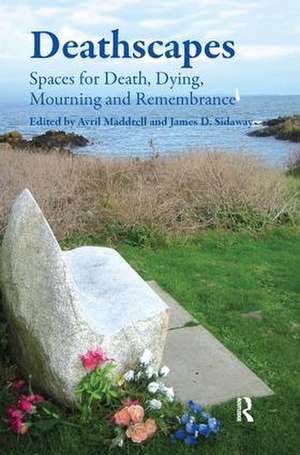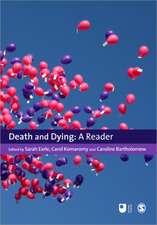Deathscapes: Spaces for Death, Dying, Mourning and Remembrance
Autor James D. Sidaway Editat de Avril Maddrellen Limba Engleză Paperback – 3 oct 2016
| Toate formatele și edițiile | Preț | Express |
|---|---|---|
| Paperback (1) | 469.34 lei 6-8 săpt. | |
| Taylor & Francis – 3 oct 2016 | 469.34 lei 6-8 săpt. | |
| Hardback (1) | 825.62 lei 6-8 săpt. | |
| Taylor & Francis – 28 dec 2010 | 825.62 lei 6-8 săpt. |
Preț: 469.34 lei
Nou
Puncte Express: 704
Preț estimativ în valută:
89.81€ • 94.20$ • 74.76£
89.81€ • 94.20$ • 74.76£
Carte tipărită la comandă
Livrare economică 01-15 aprilie
Preluare comenzi: 021 569.72.76
Specificații
ISBN-13: 9781138269484
ISBN-10: 1138269484
Pagini: 328
Dimensiuni: 156 x 234 x 18 mm
Greutate: 0.45 kg
Ediția:1
Editura: Taylor & Francis
Colecția Routledge
Locul publicării:Oxford, United Kingdom
ISBN-10: 1138269484
Pagini: 328
Dimensiuni: 156 x 234 x 18 mm
Greutate: 0.45 kg
Ediția:1
Editura: Taylor & Francis
Colecția Routledge
Locul publicării:Oxford, United Kingdom
Notă biografică
Avril Maddrell, University of the West of England, UK and James D. Sidaway,University of Amsterdam, the Netherlands
Recenzii
'This remarkable, genuinely inter-disciplinary collection examines the spaces, places and landscapes of death and bereavement in western societies. Elegantly written and impeccably researched, these essays underline how western attitudes to death are geographically constituted. Deathscapes provides an unflinching, unsentimental and often moving commentary on the last great taboo of the modern age.' Mike Heffernan, University of Nottingham, UK 'Deathscapes is more than the sum of its interdisciplinary parts. It describes living with death, locating burial spaces and negotiating sites of mourning while linking historical and contemporary funerary trends across wide geographical tracts. This imaginative collection builds a powerfully integrated picture of human mortality. Experts and the curious will not be disappointed.' Douglas J. Davies, Durham University, UK 'This multidisciplinary collection presents important new insights into the spaces and places of death and dying. Bringing together theoretically and empirically rich approaches to subjects as varied as near death experiences, green burial and memorial art, the editors provide an indispensable guide to the inevitable.' Joyce Davidson, Queen's University, Canada 'Students and scholars will find this book a useful and thought-provoking addition for the spatial study of death and dying... [The contributors are] fully interdisciplinary, including scholars from sociology, public health, anthropology, history of art and architecture.' Area 'I congratulate the authors and editors on their contribution to the field of necrogeographical scholarship. This volume in particularly provides some interesting discussions and raises some critical points about an unavoidable part of life (and therefore planning) that is rarely considered.' Australian Planner 'This book will definitely be successful in attracting more people to the important topics of geographies of death, dying and remembrance. It is convincing as it gives
Cuprins
1: Introduction; I: At the Threshold – Living with Death; 2: ‘It's Not Really Like a Hospice' Spaces of Self-help and Community Care for Cancer; 3: Laying Lazarus to Rest; II: Spaces of Burial; 4: Buried Bodies in an East London Cemetery; 5: From Anti-social Behaviour to X-rated; 6: Rest in Peace? Burial on Private Land; 7: From Cabbages to Cadavers; III: Negotiating Space for Memorialisation in Private and Public Space; 8: The Production of a Memorial Place; 9: Bringing the Dead Back Home; 10: Memorialisation of US College and University Tragedies; 11: Private Spaces for the Dead; IV: Art and Design in Service of Remembrance and Mourning; 12: Living to Living, Living to Dead; 13: Maxwell Fry and the ‘Anatomy of Mourning'; 14: The Living, The Dead and the Imagery of Emptiness and Re-appearance on the Battlefields of the Western Front; 15: Art and Mourning in an Antarctic Landscape
Descriere
This multi-disciplinary study addresses the relationships between space and place, death and bereavement in western societies, from the mapping of bereavement on the body or in domestic space, to sites of burial or cremation in public and private space. Current debates within academia and wider society are also addressed in chapters on green and garden burial, negotiating emotion in public/private space, remembrance of violence and disaster, and virtual space.










